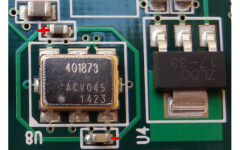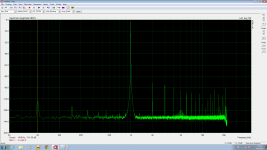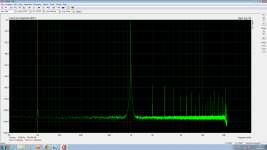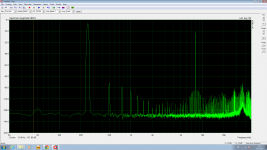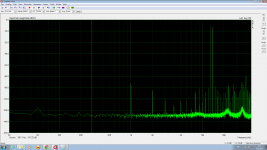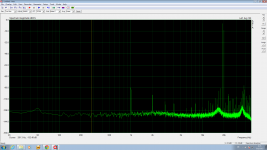Indeed it would be very interesting to measure the clock power feed. I soldered an OSCON 330uF/6.3V from Vdd to GND near the oscillator and hear a more black background, more precision and more details.
----------------------------------------------------------------------------------------------------------------------
Actual system: DAM1021 0,05%, DIYINHK TPS7A4700 power, 4 OSCON 330uF/6.3V capacitors 4V reference, 1 OSCON 330uF/6.3V capacitor oscillator supply
----------------------------------------------------------------------------------------------------------------------
Actual system: DAM1021 0,05%, DIYINHK TPS7A4700 power, 4 OSCON 330uF/6.3V capacitors 4V reference, 1 OSCON 330uF/6.3V capacitor oscillator supply
Solder points are marked with + and -.
Photos with courtesy of glt.
So, if I see correctly, you can conveniently use the vias for back side mounting as well?
Has anybody tried to shield/cover the resistor banks with copper foil or similar?
That rather huge and sensitive open area might pick up this or that EMI/RFI/interference,,,
Just an idea.
I think an CNCed aluminum or copper Enclosure will be perfect for that, but how the wires can go through it will be another problem
There's another excellent reason.Vinyl copies often have a superior mastering over the CD release better suited to our high expectations with how things should be done.
I'm actually running my vinyl through my dam via a AD24QS-K ADC (CS5381) and it simply sounds better even without the pure analog path to the amplifier.
Nightwish Imaginaerum is a great example.
And sometimes the SACD version is superior in mastering (fewer problems) compared to CD, so I've been investing in some SACD's (not necessarily because technical differences / format).
I build an DAC based in the Beis DA2496 with CS4398, and results better than every onboard PC board I have tested. But for good sounding I filtered the enormous CS HF hash with an signal quality DIY trafo (most opamps don't filter that well).I've been wondering how good these beis converters are. What's your verdict? At a quick glance it seems the ADC doesn't use a special clock, there are no jitter specs availible and the PSU is very basic.
Good idea!It would be great if everyone detailing their experiences with mods would add a short description of their exact configuration in that post: Power supply (trafo only, unregulated but filtered, discrete regulated, batteries etc.), all mods done to the DAM, input used (S/PDIF, IS2, etc.), output used.
Otherwise it's hard to figure out even from skipping through the thread what configuration people are actually listen to.
I are usind my DAM with batteries supply, S-PDIF with original bit/samplerate from Foobar/W7 WASAPI. S-PDIF are from an Asus Xonar audio board (my measurements are from this same board, is good for mesuring!). I tested various musical styles, from 128kbps MP3 (YIKES!) to 192kHz/24bits (and decoded some SACD iso with 176kHz/24bits), with good results. I removed the output opamps and use direct out. My mod are described at earlier posts, but in resume is decoupled with 470µF/16V Nichicon FP at every 4V supply and 5V supply, with an 47µF cap to make supply behave like an normal unity gain buffer (risky). My speakers are the Troel's Gravesen TQWT, and amps are various (300B SET, 60+60W PL509PP, 12AL11 Frank B. MTA, old tuned AD161/162 Ge amp, GT806B SE follower amp, and some other...).
I'm not a reviewer and I not know how to describe what I hear ... but in short, the sound seems pretty clean, great for listening to classical / classical music, but that DAC is more revealing of digititis from some recordings than my other DAC that uses PCM1704 +trafoIV+Aikido E88CC in output, which is more "forgeting" in this regard.
So, if I see correctly, you can conveniently use the vias for back side mounting as well?
Yes, should work too.
I think an CNCed aluminum or copper Enclosure will be perfect for that, but how the wires can go through it will be another problem
Additionally there is the gate array working as emi source too. Sometimes you can find some emi shielding pads sticked on top of the chips. But in any case I doubt that we can measure such influence with diy equipment ...
Has anybody tried to shield/cover the resistor banks with copper foil or similar?
That rather huge and sensitive open area might pick up this or that EMI/RFI/interference,,,
Just an idea.
It should be possible to use some technical fabrics like this one
http://www.aaronia.com/products/shielding-screening
Hi Dimdim,
thanks for the code!
I´ve made my own Arduino code, which is not so sophisticated, but there is one interesting feature! I´ve implemented the possibility to transfer filters, which are stored on a SD-card per xmodem. So you can put your favourite filter files on the SD-card and transfer it on the fly to the dam1021!
https://www.dropbox.com/sh/honm3yrsw...ENNIZkpMa?dl=0
This program uses the following devices:
1 x SainSmart IIC/I2C/TWI 1602 Serial LCD Modul Display
1 x SunFounder SD Card Module Slot Socket Reader for Arduino UNO R3 Mega 2560 Nano
1 x http://www.amazon.de/Qualität-MAX323...uino+rs232+ttl
Have fun!
Christian
thanks for the code!
I´ve made my own Arduino code, which is not so sophisticated, but there is one interesting feature! I´ve implemented the possibility to transfer filters, which are stored on a SD-card per xmodem. So you can put your favourite filter files on the SD-card and transfer it on the fly to the dam1021!
https://www.dropbox.com/sh/honm3yrsw...ENNIZkpMa?dl=0
This program uses the following devices:
1 x SainSmart IIC/I2C/TWI 1602 Serial LCD Modul Display
1 x SunFounder SD Card Module Slot Socket Reader for Arduino UNO R3 Mega 2560 Nano
1 x http://www.amazon.de/Qualität-MAX323...uino+rs232+ttl
Have fun!
Christian
The links are dead due to the "..."Hi Dimdim,
thanks for the code!
I´ve made my own Arduino code, which is not so sophisticated, but there is one interesting feature! I´ve implemented the possibility to transfer filters, which are stored on a SD-card per xmodem. So you can put your favourite filter files on the SD-card and transfer it on the fly to the dam1021!
https://www.dropbox.com/sh/honm3yrsw...ENNIZkpMa?dl=0
This program uses the following devices:
1 x SainSmart IIC/I2C/TWI 1602 Serial LCD Modul Display
1 x SunFounder SD Card Module Slot Socket Reader for Arduino UNO R3 Mega 2560 Nano
1 x http://www.amazon.de/Qualität-MAX323...uino+rs232+ttl
Have fun!
Christian
Hi Dimdim,
thanks for the code!
I´ve made my own Arduino code, which is not so sophisticated, but there is one interesting feature! I´ve implemented the possibility to transfer filters, which are stored on a SD-card per xmodem. So you can put your favourite filter files on the SD-card and transfer it on the fly to the dam1021!
https://www.dropbox.com/sh/honm3yrsw...ENNIZkpMa?dl=0
This program uses the following devices:
1 x SainSmart IIC/I2C/TWI 1602 Serial LCD Modul Display
1 x SunFounder SD Card Module Slot Socket Reader for Arduino UNO R3 Mega 2560 Nano
1 x http://www.amazon.de/Qualität-MAX323...uino+rs232+ttl
Have fun!
Christian
This is some excellent work Christian!
I too started writing code to implement this functionality but then Soren said that the new firmware would allow several filters to be loaded to the DAM at the same time so I didn't bother to finish it.
Tomorrow I'm going away on holidays for a couple of weeks so I'll be away from my DAM and my Arduinos but when I get back I will definitely give your code a try!
Thanks again..
Hi,
here are some photos to understand how the appliance works. At the backside of the case are the connectors for RS232 and the SD-Card slot. You see the display is very simple.
I´ve built the following functionality:
1. Display the status of the dam1021: volume, channel and the sampling rate
2. Infrared remote to control: volume, channel, mute, switching off the display and sd-programming (you can use every remote, you have only to know the codes. I´ve put a little "code harvester" program to the zip to read the codes of any remote, you want to use)
3. Sd-programming: select a filter file on the sd-card and transfer it to the dam1021
https://www.dropbox.com/s/7yb2j50j721d12q/IMG_0168.JPG?dl=0
https://www.dropbox.com/s/qinvvij17rmecp0/IMG_0171.JPG?dl=0
https://www.dropbox.com/s/5omagvj1c4vr7ce/IMG_0172.JPG?dl=0
https://www.dropbox.com/s/tsmxdjnjz23cy81/IMG_0173.JPG?dl=0
The software has some little bugs. I will remove it with the new firmware. Sometimes the RS232 of the dam1021 seems to hang. It is very important to use an adequate supply 5V 2A for the Arduino. I think the RS232 is a little bit hungry.

Christian
here are some photos to understand how the appliance works. At the backside of the case are the connectors for RS232 and the SD-Card slot. You see the display is very simple.
I´ve built the following functionality:
1. Display the status of the dam1021: volume, channel and the sampling rate
2. Infrared remote to control: volume, channel, mute, switching off the display and sd-programming (you can use every remote, you have only to know the codes. I´ve put a little "code harvester" program to the zip to read the codes of any remote, you want to use)
3. Sd-programming: select a filter file on the sd-card and transfer it to the dam1021
https://www.dropbox.com/s/7yb2j50j721d12q/IMG_0168.JPG?dl=0
https://www.dropbox.com/s/qinvvij17rmecp0/IMG_0171.JPG?dl=0
https://www.dropbox.com/s/5omagvj1c4vr7ce/IMG_0172.JPG?dl=0
https://www.dropbox.com/s/tsmxdjnjz23cy81/IMG_0173.JPG?dl=0
The software has some little bugs. I will remove it with the new firmware. Sometimes the RS232 of the dam1021 seems to hang. It is very important to use an adequate supply 5V 2A for the Arduino. I think the RS232 is a little bit hungry.
Christian
User in Hong Kong build his own OLED display for soekris R2R DAC
adding additional I2S and SPDIF input.
One I2S input either for Chinese famous
TANYU CDM3/4 CD player
???CDM3/4???? - ?Feverhifi ?????? - ??HIFI???? - Powered by Discuz!
or
Stock Fish CDPro2 CD player
another I2S input for Amanero Combo 384
Amanero Technologies
I like the OLED Display
Where can I find more information?
Some measurement before my Vref Mod
Some measurements before my mod.
1. Please note that there are small peaks at odd multiples of 50Hz, say 150Hz and 250Hz.
After swapping a pair of wires from transformer to the negative regulator, the 150 and 250 peaks were gone. The 50Hz peak decreased by about 12db.
2. The artifacts around 5kHz were also gone.
3. Distortion & Noise figures are not bad. (see the bottom left corner of the second figure)
4. Any experts can explain?
5. I don't know whether the IMD is serious or not.
Measurement were made with RME AIO soundcard with ARTA.
Power supply is Salas Shunt without remote sensing,
C101 and C103 replaced by Oscon caps.
Some measurements before my mod.
1. Please note that there are small peaks at odd multiples of 50Hz, say 150Hz and 250Hz.
After swapping a pair of wires from transformer to the negative regulator, the 150 and 250 peaks were gone. The 50Hz peak decreased by about 12db.
2. The artifacts around 5kHz were also gone.
3. Distortion & Noise figures are not bad. (see the bottom left corner of the second figure)
4. Any experts can explain?
5. I don't know whether the IMD is serious or not.
Measurement were made with RME AIO soundcard with ARTA.
Power supply is Salas Shunt without remote sensing,
C101 and C103 replaced by Oscon caps.
Attachments
Last edited:
- Home
- Vendor's Bazaar
- Reference DAC Module - Discrete R-2R Sign Magnitude 24 bit 384 KHz
